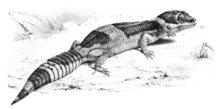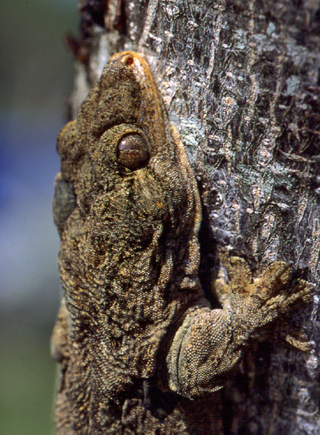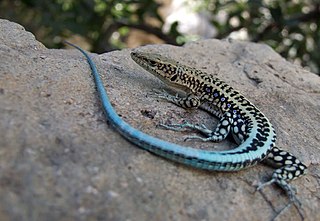
Gekkonidae is the largest family of geckos, containing over 950 described species in 64 genera. The Gekkonidae contain many of the most widespread gecko species, including house geckos (Hemidactylus), the tokay gecko (Gekko), day geckos (Phelsuma), the mourning gecko (Lepidodactylus), and dtellas (Gehyra). Gekkonid geckos occur globally and are particularly diverse in tropical areas.

Eurydactylodes is a small genus of geckos commonly referred to as chameleon geckos from the subfamily Diplodactylidae, endemic to New Caledonia and few adjacent islands. Within the Diplodactylidae, Eurydactylodes resides in the Carphodactylini tribe, and consists of four species. All species share similar morphology as well as lifestyle and habits. The first of the Eurydactylodes species to be classified, E. vieillardi, was discovered in 1869.

The East Indian leopard gecko, also known commonly as Hardwicke's gecko, is a species of gecko, a lizard in the family Eublepharidae. The species is endemic to India and Bangladesh.
The Ponmudi day gecko is a species of lizard in the family Gekkonidae. The species is endemic to India.

The Virgin Islands dwarf sphaero, Virgin Gorda least gecko, or Virgin Islands dwarf gecko is a species of gecko and also one of the smallest terrestrial vertebrates. It has only been found on three of the British Virgin Islands: Virgin Gorda, Tortola, and Moskito Island. It was discovered in 1964 and is suspected to be a close relative of Sphaerodactylus nicholsi, a dwarf sphaero from the nearby island of Puerto Rico. It shares its range with the big-scaled least gecko (S. macrolepis), which is found in leaf litter. Unlike this larger gecko, the Virgin Islands dwarf sphaero lives on drier hillsides, yet prefers moist microhabitats found under rocks because it lacks the adaptations necessary for preventing water loss, which is a significant problem due to its small body size.
The Cà Ná marbled gecko is a species in the Gekko genus, Gekkonidae family, first found from Southern Vietnam in 2011.

Gehyra georgpotthasti is a species of web-toed gecko, found on several Melanesian and Polynesian islands.
Cyrtodactylus buchardi is a species of gecko, a lizard in the family Gekkonidae. The species is endemic to Laos.

Cyrtodactylus cattienensis, or the Cattien bent-toed gecko, is a gecko endemic to southern Vietnam. It is known from the Đồng Nai and Bà Rịa–Vũng Tàu provinces. Its type locality is within the Cát Tiên National Park, and the species was named after the park.

Cnemaspis podihuna, also known as Deraniyagala's day gecko or dwarf day gecko is a species of diurnal gecko found only in Sri Lanka.
Lucasium byrnei, also known commonly as the gibber gecko, Byrne's gecko, and the pink-blotched gecko, is a species of small, nocturnal lizard in the family Diplodactylidae. The species is endemic to Australia.

Strophurus williamsi, also known commonly as the eastern spiny-tailed gecko, the soft-spined gecko, and Williams' spiny-tailed gecko, is a species of lizard in the family Diplodactylidae. The species is endemic to semi-arid regions of eastern Australia including Queensland, New South Wales, Victoria and South Australia. It has become a popular species as a pet for its distinctive tail features. S. williamsi has been grouped within a clade of seven other species that are believed to have diverged from their ancestors around 20 million years ago. S. williamsi can be distinguished from closer relatives by arboreality and diurnal (day-active) activity.

Phelsuma vanheygeni is a species of gecko, a lizard in the family Gekkonidae. The species is endemic to Madagascar.
Hemidactylus pieresii is a species of gecko. It is endemic to Sri Lanka.
Natalie's toad-headed agama is a species of agamid lizard endemic to the Zagros Mountains in Iran. The specific epithet honors Natalia Ananjeva of the Zoological Institute in St. Petersburg, Russia for her contribution to herpetological research of the family Agamidae and Phrynocephalus in particular.
Apathya yassujica, the Yassujian lizard, is a species of lizard endemic to Iran.

The Anatolian lizard is a species of lizard endemic to Iran, Iraq, Syria and Turkey.
Cnemaspis kotagamai, or Kotagama's day gecko, is a species of diurnal gecko endemic to island of Sri Lanka, described in 2019 from Ratnapura.
Cnemaspis dissanayakai, or Dissanayaka's day gecko, is a species of diurnal gecko endemic to island of Sri Lanka, described in 2019 from Polonnaruwa.
Cnemaspis kawminiae, or Kawmini's day gecko, is a species of diurnal gecko endemic to island of Sri Lanka, described in 2019 from Nuwara Eliya.









